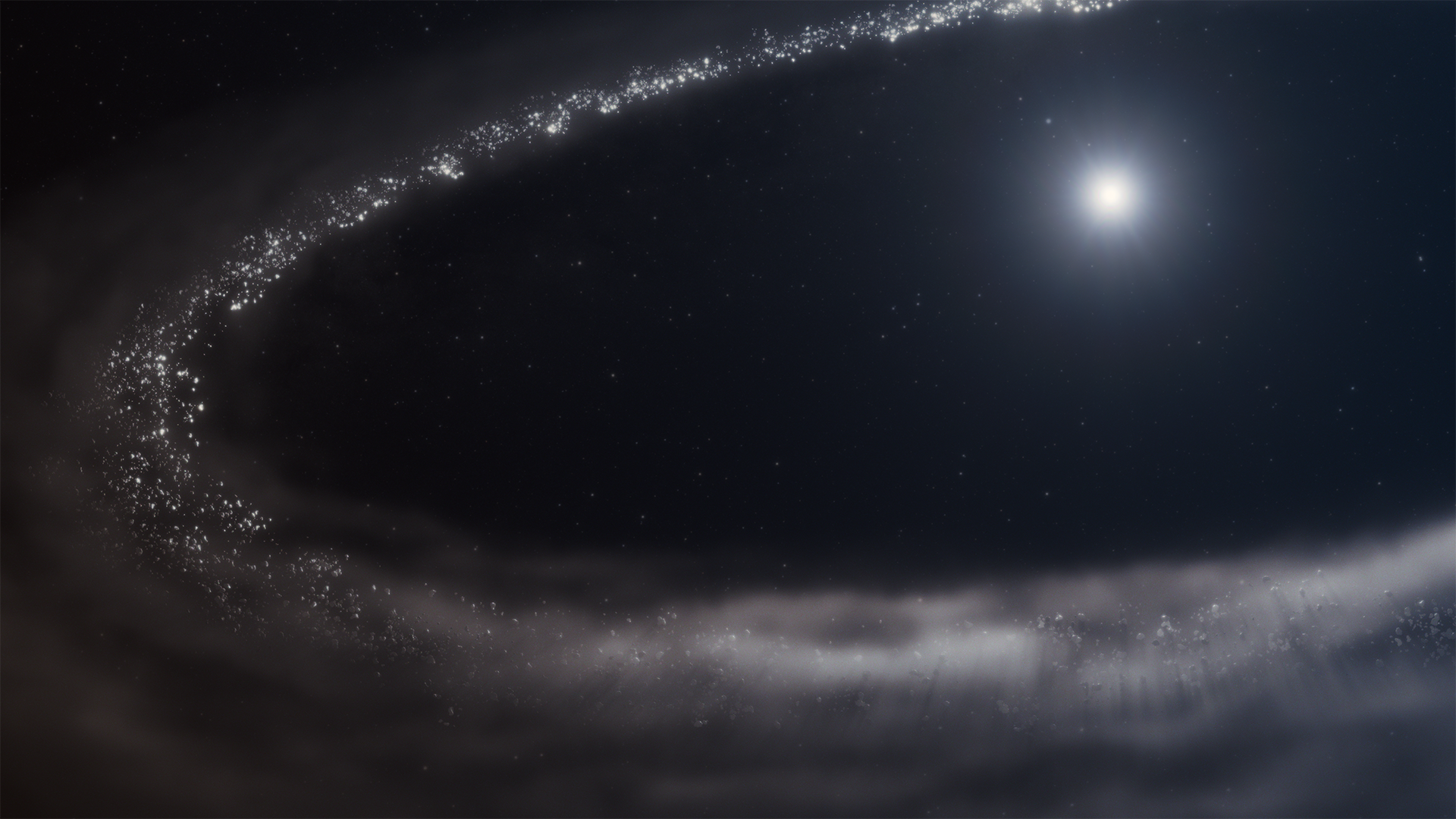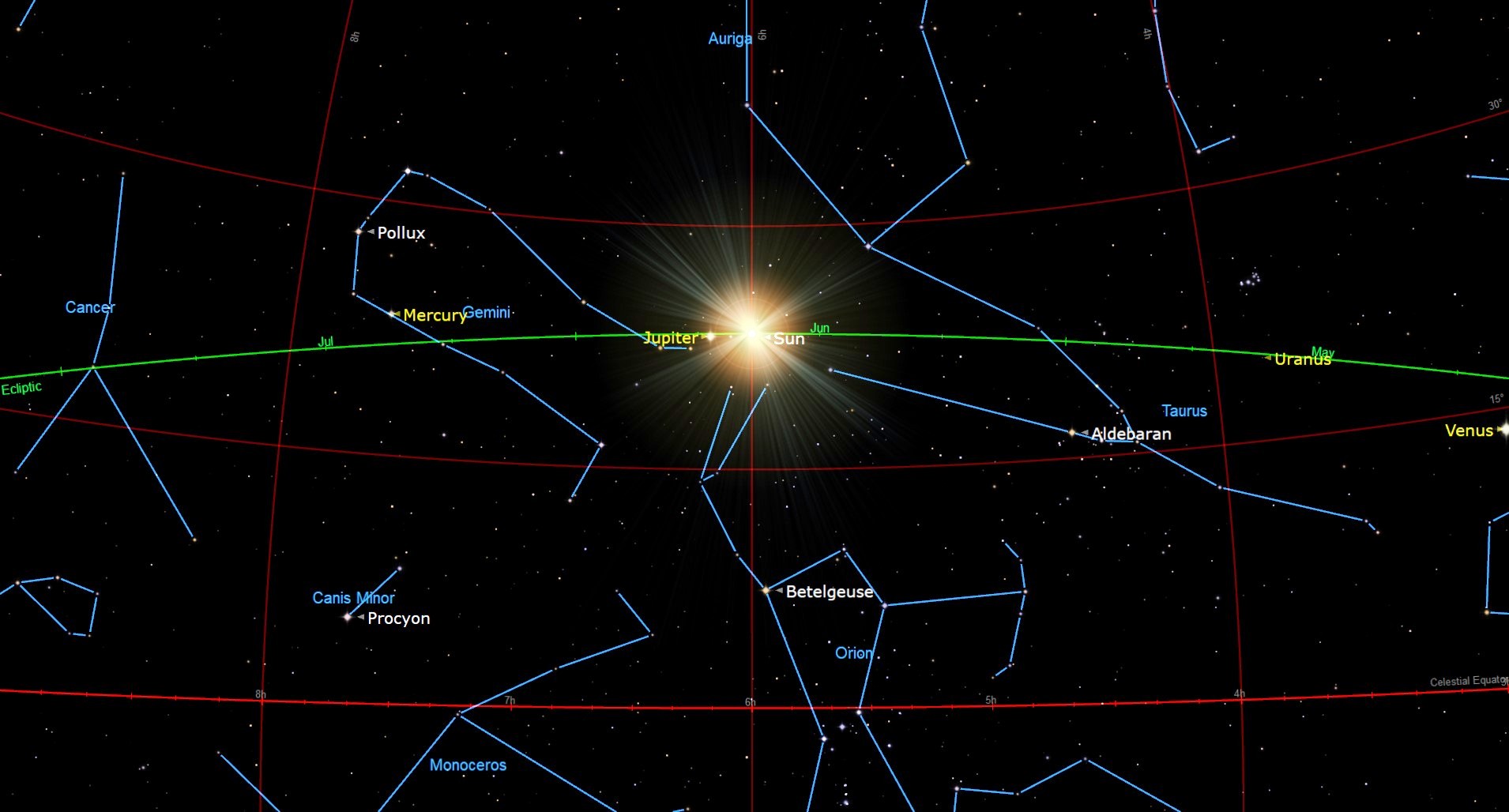James Webb Space Telescope discovers an alien planetary system's icy edge
"Basically, we detected a water–ice reservoir."

At long last, particles of water–ice have been discovered in the frozen Kuiper Belt of another star. The discovery, made by the James Webb Space Telescope, is a major step forward in filling in gaps in our understanding of how exoplanets develop.
Like the Kuiper Belt in our solar system, this extraterrestrial debris disk is likely filled with comets, dwarf planets and a lot of water-ice particles chipped off larger bodies as the result of collisions. The debris disk, also like our Kuiper Belt, is made up of remnants of a larger disk that once encircled the star — called HD 181327 — and probably gave birth to planets. To be clear, however, no planets in the region have been detected thus far.
Because water is one of the most common molecules in the universe, its presence in HD 181327's debris disk is not a surprise. Indeed, exocomets have been detected around other stars; in our solar system, comets come from the frigid, icy Kuiper Belt and the Oort Cloud, so exocomets must originate from somewhere similar.
However, while debris disks around other stars have been known about and imaged ever since the Infrared Astronomy Satellite (IRAS) found debris disks around two nearby stars (Vega and beta Pictoris) a while back, we've not had an instrument able to detect water-ice within them until now.
Using the James Webb Space Telescope (JWST) and its Near-Infrared Spectrometer (NIRSpec), astronomers led by Chen Xie of Johns Hopkins University in the United States probed the debris disk around HD 181327. The star and its debris disk have previously been well-studied. Located 155.6 light-years away, they are just 18.5 million years old. This is extremely young compared to our sun's age of 4.6 billion years. The star is an F-type, meaning it's a little hotter and slightly more massive than our sun.
NIRSpec detected the signature water in HD 181327's spectrum, principally at a wavelength of 3 microns (millionths of a meter), with a peak coming at 3.1 microns. This spike in the spectrum, referred to as a "Fresnel peak," is caused by the refraction of light by water-ice particles that are just millimeters in size. This is similar in size to the icy particles in Saturn's rings, for example, and the ice is likely frozen around motes of interplanetary dust.
"Basically, we detected a water–ice reservoir," Xie told Space.com.
Breaking space news, the latest updates on rocket launches, skywatching events and more!
This water–ice reservoir could be instrumental in the development of any planetary system that might exist around HD 181327. Gas giant planets, for example, form beyond a boundary called the snow line, which is the distance from a star where temperatures are cold enough for planet-forming material to contain water-ice. Water-ice helps material stick together in a giant kind of mush that can form the basis of a large, rocky planetary core that can then pull in gas to form the distended atmosphere of a giant planet.
The water on terrestrial planets such as Earth also likely was delivered by asteroids and/or comets that formed beyond the snow line and are rich in water-ice. Therefore, the discovery of water-ice in HD 181327's debris disk means the materials are present there to aid in the development of any planets orbiting the star, although at this time no planets have yet been detected in the system.
"The presence of a water-ice reservoir in the planetesimal belt around HD 181327 provides the potential to deliver water to nearby planets," said Xie. "But we don't know how much water-ice could eventually be delivered to the planets in the system."
It's tempting to make comparisons between our Kuiper Belt and HD 181327's debris disk. Xie warns about being too literal in the comparison, though, because there are significant gaps in our knowledge of both icy belts and how they relate to each other. Nevertheless, we can draw some general conclusions.
"The presence of water-ice in a debris disk around such a young star does suggest that icy planetesimals can form relatively quickly, so it's possible that icy bodies in our own Kuiper Belt could have formed early in the cold outer regions of the solar system," he said. Their early existence could have then helped in the development of the solar system's planets.
However, the planet-forming disk around HD 181327 has now dissipated, and any planets that are present will have already formed. Furthermore, the JWST's observations show how the inner region of the debris disk is being eroded by the star's ultraviolet light. The strength of the spectral line for water-ice at the inner edge of the debris disk, 80 to 90 astronomical units (meaning 80 to 90 times Earth's distance from the sun), suggests water-ice makes up just 0.1% of the total mass in that part of the disk. Farther out, between 90 and 105 astronomical units, the water-ice mass fraction rises to 7.5%, and between 105 and 120 astronomical units it peaks at 21%, out where it is coldest. Coincidentally, the Fresnel peak is found between 90 and 105 astronomical units.
So, what's going on? Ultraviolet light from the star is able to vaporize the water-ice, but something seems to be replenishing it — otherwise, the water-ice in the debris disk would have eroded away by now.
This replenishment likely comes from collisions between dwarf planets, cometary nuclei, micrometeoroids and other flotsam and jetsam lurking in the dark of the debris disk. Each impact sputters more dust and ice grains into space, and each large impact sends a shower of fragments spinning away. If there's enough dust present, it could also shield water-ice from the star's ultraviolet light. Dust that has been detected already includes grains of olivine and iron sulfide.
Meanwhile, the Atacama Large Millimeter/submillimeter Array (ALMA), which is a radio telescope in Chile, has detected carbon monoxide in the debris disk, which could also have been released into space by collisions between icy bodies. In addition, the JWST's NIRSpec found tentative evidence for the presence of carbon dioxide in the region of the disk between 105 and 120 astronomical units from the star, although this still needs to be confirmed. A second spectral line for water-ice, at 4.5 microns, was also detected by the JWST in the 105 to 120 astronomical-unit region, indicating this outer part of the debris disk might be the most rich in volatiles: gases with low evaporation points.
Now that the JWST has demonstrated that it can detect water-ice in exoplanetary systems, we can expect more widespread discoveries in the future. Indeed, Xie and his team are already working on it.
"Besides HD 181327, we have also observed other systems with the JWST and NIRSPec," he said. "We're currently working on publishing those data, so stay tuned!"
The discovery of water-ice around HD 181327 was published on May 14 in the journal Nature.
Join our Space Forums to keep talking space on the latest missions, night sky and more! And if you have a news tip, correction or comment, let us know at: community@space.com.

Keith Cooper is a freelance science journalist and editor in the United Kingdom, and has a degree in physics and astrophysics from the University of Manchester. He's the author of "The Contact Paradox: Challenging Our Assumptions in the Search for Extraterrestrial Intelligence" (Bloomsbury Sigma, 2020) and has written articles on astronomy, space, physics and astrobiology for a multitude of magazines and websites.
You must confirm your public display name before commenting
Please logout and then login again, you will then be prompted to enter your display name.
